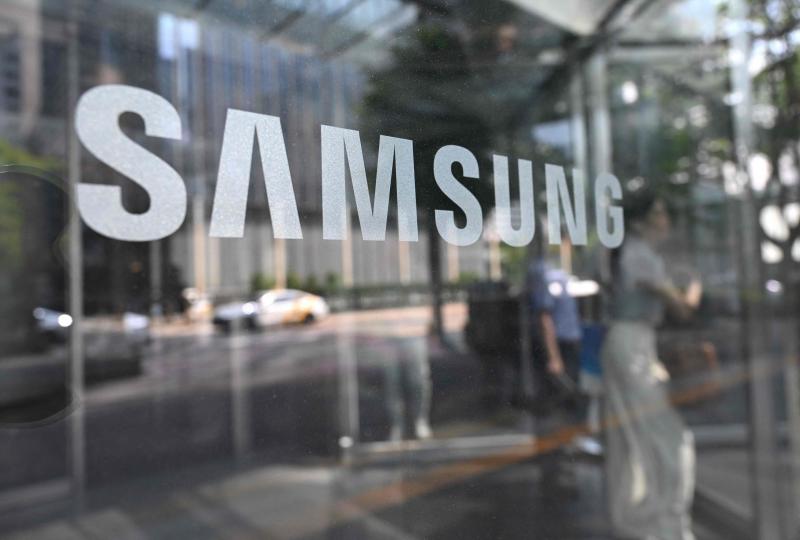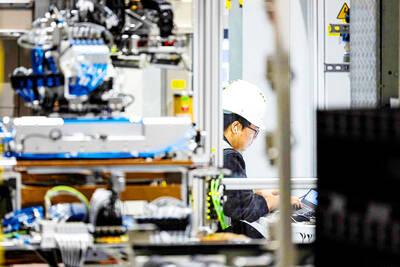Samsung Electronics Co’s chip unit saw profit plunge a far bigger-than-expected 94 percent in the June quarter, reflecting the depth of a slump that’s plaguing the world’s largest memory chipmaker.
The weak results at the pivotal business underline how far Samsung has fallen in the lucrative artificial intelligence (AI) arena, where SK Hynix Inc leads in high-end memory and Taiwan Semiconductor Manufacturing Co (TSMC, 台積電) dominates in contract chipmaking.
The chip arm today reported three-month operating profit of 400 billion won (US$288 million), the lowest in six quarters, versus analysts’ average projection for 2.73 trillion won.

Photo: Jung Yeon-je, AFP
The decline stemmed largely from a one-time inventory cost as US export controls led to unsold AI chips at its foundry business, which relies in part on Chinese demand. The profit decline was despite solid demand for high-end memory products for servers, the company said.
Shares of South Korea’s largest company fell as much as 1.8 percent this morning in Seoul.
The grim results reflect Samsung’s poor performance on high-bandwidth memory (HBM), Counterpoint research director MS Hwang said. Samsung’s share in the global HBM market slipped to 17 percent in the second quarter in terms of bit volume, down from more than 40 percent in the first quarter of last year, he said.
“This suggests that Samsung has fallen behind even Micron Technology Inc to rank No. 3,” in the second quarter, he said.
Samsung will “actively respond” to demand for higher-density memory, the company said. Operating losses at Samsung’s foundry unit are expected to narrow in the second half of the year on a gradual recovery in demand, the company said.
Samsung’s underwhelming quarterly report comes after the company early this week won a US$16.5 billion contract from Tesla Inc to produce AI chips at an upcoming plant in Taylor, Texas.
The company has been stepping up spending on research and development and front-end capacity in its efforts to catch up with SK Hynix and Micron in AI memory chips. Samsung has struggled to get its latest products certified by Nvidia Corp — providing an unusually long window for SK Hynix to carve out commanding leads in the booming AI memory market.
At the same time, it has been trying to win large customers away from contract chipmaking powerhouse TSMC to revive its ailing foundry division where operating rates have plunged. TSMC has begun production in Arizona and is ramping up capacity in the US, while Samsung has slowed completion of its Taylor plant, now scheduled to start operating next year.
A successful implementation of the multi-year deal with Tesla would improve Samsung’s prospects for winning more clients and validate its technology for 2-nanometer mass production.
Investors are also looking for clues as to whether Samsung will benefit from Nvidia’s resumption of sales of its H20 AI chips to China. Samsung’s less advanced HBM3 has been used alongside H20 chips in the past.
Samsung said net income came to 4.93 trillion won in the June quarter, missing the analysts’ estimate of 6.37 trillion won.
Fears about missing first-mover advantages in AI have weighed on Samsung. That’s despite solid double-digit profitability in its mobile segment, which reported solid sales of its Galaxy S25 phones. Samsung hopes to maintain momentum through the recently released Galaxy Z Fold and Z Flip as well as the debut of its first trifold smartphone later this year.

CHIP RACE: Three years of overbroad export controls drove foreign competitors to pursue their own AI chips, and ‘cost US taxpayers billions of dollars,’ Nvidia said China has figured out the US strategy for allowing it to buy Nvidia Corp’s H200s and is rejecting the artificial intelligence (AI) chip in favor of domestically developed semiconductors, White House AI adviser David Sacks said, citing news reports. US President Donald Trump on Monday said that he would allow shipments of Nvidia’s H200 chips to China, part of an administration effort backed by Sacks to challenge Chinese tech champions such as Huawei Technologies Co (華為) by bringing US competition to their home market. On Friday, Sacks signaled that he was uncertain about whether that approach would work. “They’re rejecting our chips,” Sacks

It is challenging to build infrastructure in much of Europe. Constrained budgets and polarized politics tend to undermine long-term projects, forcing officials to react to emergencies rather than plan for the future. Not in Austria. Today, the country is to officially open its Koralmbahn tunnel, the 5.9 billion euro (US$6.9 billion) centerpiece of a groundbreaking new railway that will eventually run from Poland’s Baltic coast to the Adriatic Sea, transforming travel within Austria and positioning the Alpine nation at the forefront of logistics in Europe. “It is Austria’s biggest socio-economic experiment in over a century,” said Eric Kirschner, an economist at Graz-based Joanneum

BUBBLE? Only a handful of companies are seeing rapid revenue growth and higher valuations, and it is not enough to call the AI trend a transformation, an analyst said Artificial intelligence (AI) is entering a more challenging phase next year as companies move beyond experimentation and begin demanding clear financial returns from a technology that has delivered big gains to only a small group of early adopters, PricewaterhouseCoopers (PwC) Taiwan said yesterday. Most organizations have been able to justify AI investments through cost recovery or modest efficiency gains, but few have achieved meaningful revenue growth or long-term competitive advantage, the consultancy said in its 2026 AI Business Predictions report. This growing performance gap is forcing executives to reconsider how AI is deployed across their organizations, it said. “Many companies

France is developing domestic production of electric vehicle (EV) batteries with an eye on industrial independence, but Asian experts are proving key in launching operations. In the Verkor factory outside the northern city of Dunkirk, which was inaugurated on Thursday, foreign specialists, notably from South Korea and Malaysia, are training the local staff. Verkor is the third battery gigafactory to open in northern France in a region that has become known as “Battery Valley.” At the Automotive Energy Supply Corp (AESC) factory near the city of Douai, where production has been under way for several months, Chinese engineers and technicians supervise French recruits. “They